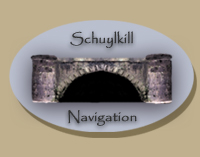
Schuylkill Navigation Maps
at
Reading Area Community College

 Schuylkill Navigation Maps at Reading Area Community College |
||
 |
|
History of the Schuylkill Navigation System
|
||||||||
| The Schuylkill Navigation Company was incorporated in 1815 for the purpose of making the Schuylkill River navigable. In the State Archives of Pennsylvania Manuscript Group 110 there are copies of the legislative acts, minute books, correspondence, reports, and other documents of the company from 1815 until 1947 when the property was contributed to the Commonwealth of Pennsylvania. In the 1947 report Appraisal Schuylkill Navigation Company Canal for Commonwealth of Pennsylvania a "Brief History Of The Property To Be Appraised" is included. | ||||||||
|
The "canal" or navigation system was constructed between Port Carbon and Philadelphia and covered a distance of 108 miles. Harry L. Rinker in his book, The Schuylkill Navigation: a Photographic History, points out that this "canal" was more properly a "navigation system" because it consisted of 18 dams, 23 canals which covered 57.73 miles, 120 locks, 17 stone aqueducts, one 450 foot long tunnel, 50.50 miles of slack water pools, 23 canals covering 57.73 miles, and 31 houses for toll and lock keepers when it was completed in May 1825. After 1825 efforts to improve the navigation system were ongoing, so the above number of structures changed over the years. There are photographs of some of the dwellings still in existence in 1947 in the Appraisal Schuylkill Navigation Company Canal for Commonwealth of Pennsylvania. |
||||||||
|
The system was most prosperous between 1835 and 1841 although its record tonnage, nearly two million tons, occurred in 1859. During the second half of the 19th century the rise of the railroad, floods, droughts, and a miners' strike contributed to the downfall of the system. In January 1870 the navigation system, was leased to the Philadelphia and Reading Railroad Company for 999 years although the railroad company was obligated to maintain the system in good condition except for the section north of Port Clinton which was abandoned around 1887. In 1896 the railroad property was sold to Coster and Stetson, but they elected not to assume the lease of the navigation system. From 1896 to 1902 the Philadelphia and Reading Railway Company operated the navigation system, but in April 1902 the Schuylkill Navigation Company resumed operations of the navigation system. In the 20th century commercial use of the navigation system decreased and ended in 1931. In 1949 the Schuylkill Navigation Company was acquired by the Commonwealth of Pennsylvania. In the late 1940s and early 1950s a joint federal and state effort, the Schuylkill River Desilting Project, dredged the river of the coal culms or particles, and constructed desilting basins. The collection at Reading Area Community College includes maps and drawings from the desilting project. |
||||||||
| The navigation system as well as the maps in the collection are divided into twelve reaches. What is a reach? In technical language it is "a continuous section of canal bounded by control structures and contains one or more inflow and/or outflow points. A canal network is a system of canals served by one or more outlets of a storage area or reservoir, composed of a single canal reach or a complicated system of canal reaches." http://www.cse.fau.edu/~maria/crss.html In non-technical language it "is the flat water between two locks." http://www.schuylkillcanal.org | ||||||||
|
The Twelve Reaches of the Schuylkill Navigation |
||||||||
| The First Reach | Delaware River to Fairmount Pool | |||||||
| The Second Reach | Manayunk to Flat Rock Dam | |||||||
| The Third Reach | Conshohocken to Plymouth Dam | |||||||
| The Fourth Reach | Norristown/Bridgeport to Catfish Dam | |||||||
| The Fifth Reach | Oakes Canal from Pawling's Dam to Black Rock Dam | |||||||
| The Sixth Reach | Vincent Canal from Lock 60 to Lock 57 | |||||||
| The Seventh Reach | Girard Canal from Lock 57 to Lock 50. The Girard Canal was about 22 miles long and the longest canal on the Schuylkill Navigation. | |||||||
| The Eighth Reach | Lock 50 (Big Reading Dam) to Lock 45 (Kissinger's Dam) | |||||||
|
Lock 45 to Lock 36 in Leesport |
||||||||
| Hamburg Canal from Leesport to Kernsville Dam | ||||||||
| The Eleventh Reach | Kernsville Dam to Blue Mountain Dam | |||||||
| above Blue Mountain Dam | ||||||||
|
There are more contemporary drawings of these locations by Edward M. Kutsch, as well as, hundreds of photographs of the dams, canals, locks, and boats in Rinker's book, The Schuylkill Navigation: a Photographic History. The Schuylkill Navigation Company collection at Reading Area Community College also includes drawings of reach profiles, canal boats, bowstring bridges, mechanical parts and scows. |
||||||||
|
|
||||||||
|
Creation of this web site funded by a grant from the Commonwealth of Pennsylvania Library Services and Technology Act
|
||
|
Copyright © 2011 Reading Area Community College |
||